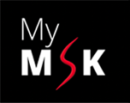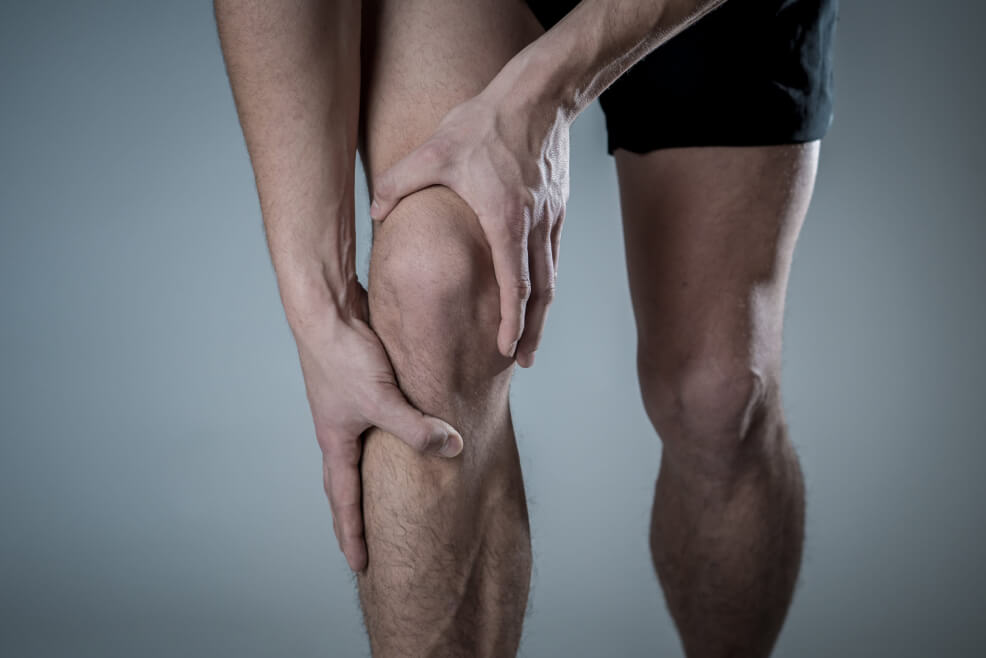
A Medial knee ligament injury is often due to a stretch or a tear of the medial ligament inside your knee. It can either be a partial tear of the ligament or a full tear where the ligament is completely torn into 2 pieces. Medial knee ligament injury is usually caused by overstretching or trauma to your knee. It usually results in severe pain and swelling on the inside of the knee. In this article, we’ll go over common symptoms of medial knee ligament injury, its causes, a few steps you could take to alleviate it at home, and some effective treatments.
Symptoms Of Medial Knee Ligament Injury:
Medial knee ligament injury is often characterised by pain and swelling on the inside of the knee. However, the intensity of these symptoms depends on the degree of the injury. Typically, medial knee ligament injury is categorised into three grades depending on the degree to which the ligament has been affected. These are:
- Grade 1 injuries often encompass mild sprains.
- Grade 2 injuries are classified as moderate sprains and may include partial ligament tears.
- Grade 3 injuries are severe sprains often involving a complete tear in the ligament.

Medial knee ligament injuries can lead to a feeling of instability in the knees, especially when getting up or walking. This instability occurs as a result of a sprained or torn ligament leading to the knee not being able to properly function and hold up the body’s weight.
Causes Of Medial Knee Ligament Injury:
Medial knee ligament injury usually occurs when your knee experiences trauma due to overstretching or getting hit. It’s quite common in sports such as football, where it is one of the most common types of football knee injury.

Football knee injuries often include the leg opening up more than it’s supposed to and the knee getting bent in the wrong direction. This can cause severe trauma to your knee ligaments leading to tears and sprains. This can happen from a tackle from the side or if the studs get caught in the grass during a jumping or turning movement.
Football isn’t the only sport that can lead to a medial knee ligament injury. Sports like rugby, hockey, and lacrosse are also more likely to result in knee ligament injuries.
Similarly, road accidents can also lead to medial knee ligament injury as your knees are often at the centre of the impact. This blunt force can extend the ligament beyond its natural capacity, stretching or even tearing it.
Sometimes, you can get knee ligament injury in your regular day-to-day activities like jumping. For instance, jumping and not landing properly can put extra stress on our knees, leading to a mild medial knee injury.
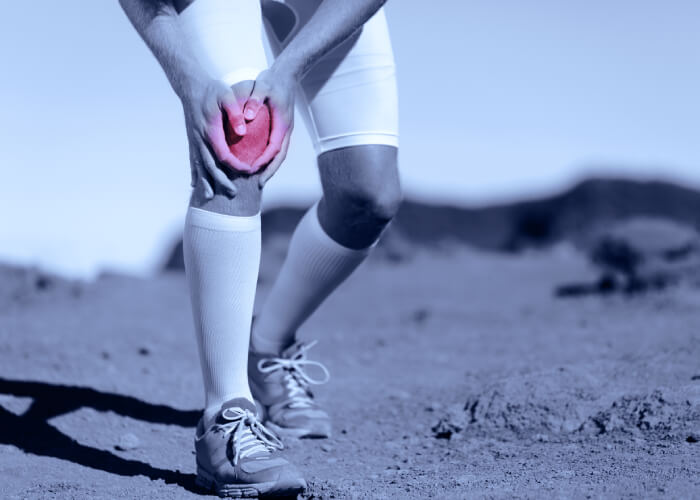
Similarly, hard bumps, trauma to the side of the knee, squatting, lifting heavy objects, or generally repeated pressure on the knees can cause medial knee ligament injury as well.
Self-Care / Manage Medial Knee Injury Pain At Home:
If you have suffered a medial knee ligament injury due to any of the reasons mentioned above, and are experiencing pain and swelling in your knee, here are a few steps you can take to manage the pain effectively at home:
1- Rest
Rest is going to be your best friend if you have a stretched or torn ligament. It gives your knee ligaments the time to naturally heal themselves. Also, keep your leg at an angle where you feel the least amount of pain to ensure that your already stressed ligament isn’t under any additional stress.
2- Using Knee Supports
Knee supports are amazing at reducing the load on your knee. After medial knee ligament injuries, the ligament requires some time to heal completely. It’s very important to not disturb this healing process by putting your knee under stress. Using knee supports allows you to move about without burdening your knee or hindering the healing process.
3- Taking Painkillers
You can take over the counter painkillers to deal with the pain caused by a medial knee injury. Painkillers can help manage the pain from an injured ligament. It’s important to remember that painkillers only numb your pain. You may not feel any discomfort while moving around after taking painkillers, but it’s still important to rest and let your medial knee injury heal. Most importantly, if the pain doesn’t go away within 24 hours of taking painkillers and resting, you should seek medical help.
4- Using Heat/Ice Packs
Ice packs are great at controlling swelling, especially immediately after sustaining an injury. If you have bumped your knee in the kitchen or have hurt your knee playing football, use an ice pack. On the other hand, heat packs are excellent for managing pain in the long term (after 72 hours from the injury) and are a great alternative for pain killers if you have moderate pain.
5- Exercise
It might seem contrary to the previous points, but exercise can actually help with the pain of a medial knee ligament injury and make it heal quicker. Make sure to perform only light exercises such as stretching, as heavy exercise can overburden the knee and aggravate the problem. The exercises are often tailored to specific muscles in the knee such as the quadriceps and calf muscles.
Diagnosis Of Medial Knee Ligament Injury:
Medial knee injury is only one of the many causes of knee pain. You may think that you are suffering from knee pain due to a medial knee injury when the actual problem is something entirely different. For example, it may be a fracture in the knee, bursitis or any other underlying conditions such as arthritis.
Hence, it’s important to diagnose the exact cause of your knee pain to devise a proper treatment plan. At MyMSK Clinic, we conduct a thorough physical examination as well as imaging tests to diagnose the medial knee injury and grade it depending on its severity.
1- Physical Examination
Our highly experienced Osteopath, Dr Akhtar, will thoroughly examine the patient’s knee, including their range of motion as well as the severity and location of the swelling, to understand the nature of the injury. In case of a medial knee injury, the swelling is usually on the inside of the knee.
2- Imaging Test:
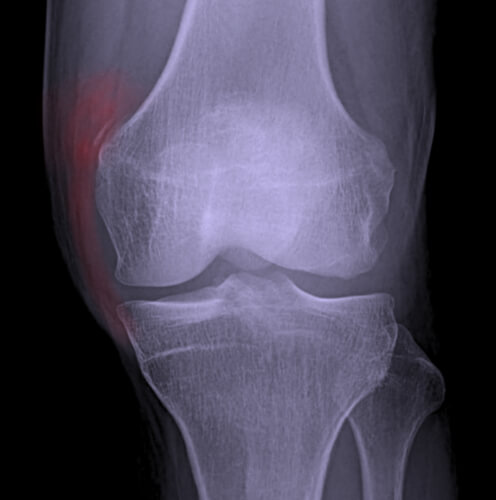
We also conduct imaging tests like MRI and Ultrasound scans within the clinic to effectively diagnose ligament injuries on top of determining their severity. Occasionally we may need to order an X-ray if we suspect a fracture in the knee joint or the bones surrounding it.
Treatment Of Medial Knee Ligament Injury:
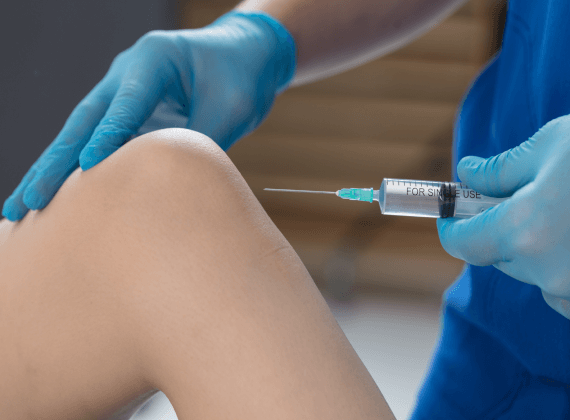
After diagnosing the medial knee injury and determining the extent and severity of the damage, we devise a treatment plan for our patients to help them manage the pain and recover from the injury. Here at MyMSK Clinic, we offer a plethora of treatment options that include:
- Medication
- Physical Therapy
- Cortisone Injection
- PRP
- Prolotherapy
- Hyaluronic Acid Injection, Ostenil Injection
1- Medication
We sometimes advise NSAIDS, OTC painkillers, or ointments to patients suffering from a medial knee injury. Plus, we may also recommend some essential nutrients and vitamins to ensure speedy recovery from the injury. The medication can vary depending upon the severity of the injury. We may also recommend other treatment options along with medication to help you recover from the injury.
2- Physical Therapy
As discussed earlier, exercise can actually lead to a speedy recovery. We usually offer physical therapy rehab exercises or osteopathy to patients suffering from a medial knee injury.
Osteopathy involves a trained Osteopath carrying out manual therapy to improve the range of motion and decrease the pain in your knee. This can be extremely beneficial in grade 1-2 medial knee injuries.
Physical therapy is highly effective, speeds up the recovery process, and helps patients regain use of their legs. It is important to keep in mind to see an osteopath or physio to carry out physical therapy, as certain forms of physical therapy can cause adverse effects and keep you in pain if not performed correctly.
3- Cortisone Injections
We also use cortisone injections to help manage the pain and inflammation in the knee. Cortisone injections effectively treat medial knee ligament injuries and help the damaged ligaments recover faster. Studies have proven that cortisone injections are extremely effective in treating the pain from meniscus tears in the knee. This often leads to a significant reduction in pain. Cortisone injections are especially useful for bringing the initial pain flare-up under control in medial ligament injuries.
4- Platelet Rich Plasma (PRP) Injections
Platelet-rich Plasma or PRP injections are used to help with the recovery process of your body. Ligament tears can sometimes take a long time to heal. Depending on the intensity of the tear and the age of the patient, it may even take years to fully heal. PRP injections aim to inject platelets (taken from the individual’s own blood) into the injured area to rejuvenate the healing process.
PRP is highly effective in promoting muscle, tendon, and ligament growth and offers a long-term solution for the medial knee injury. Depending on the severity of your injury, we may recommend multiple PRP sessions to deal with the damage effectively.
5- Prolotherapy
Prolotherapy involves injecting an irritant, like dextrose solution, into the soft tissues or ligaments of a joint to trigger the healing process. It mainly helps strengthen the tendons and ligaments in our body. That’s precisely why prolotherapy is highly effective in treating medial knee ligament injury. We use Prolotherapy in Grade 1-2 Medial ligament injuries.
When To See A Doctor?
Ideally, you should get your knee examined by a professional physician right after you hurt it. If you notice redness and swelling around the knee with unbearable pain, you should seek medical help immediately. Meanwhile, if it looks normal and the pain is bearable, you can try and manage a medial knee injury by yourself using any of the techniques we discussed above.
If the pain persists even after a few hours or you have any difficulty in moving your leg, you should consult a doctor right away.
With this in mind, Dr Akhtar from the MyMSK Clinic is a highly experienced Doctor and Osteopath in the Manchester area.
Final Thoughts:
We hope this article gives you a better understanding of what causes medial knee injury and how to treat it. Medial knee ligament injuries seem to be very daunting, but if they’re diagnosed at the right time, and proper care is taken, these injuries can be treated very easily. It is important to remember that different treatments suit different people depending on the grade of the medial knee injury, their age, lifestyle, medical history, etc.
Therefore, clinicians such as a qualified osteopath, like Dr Akhtar, are competent enough to devise a proper assessment and treatment strategy to effectively manage your medial knee injury. If you live in Manchester or Burnley and have been in an accident or suffered an injury resulting in knee pain, book an appointment (Via our Booking Page)with our knee pain specialist at MyMSK Clinic to get the best medical care.
